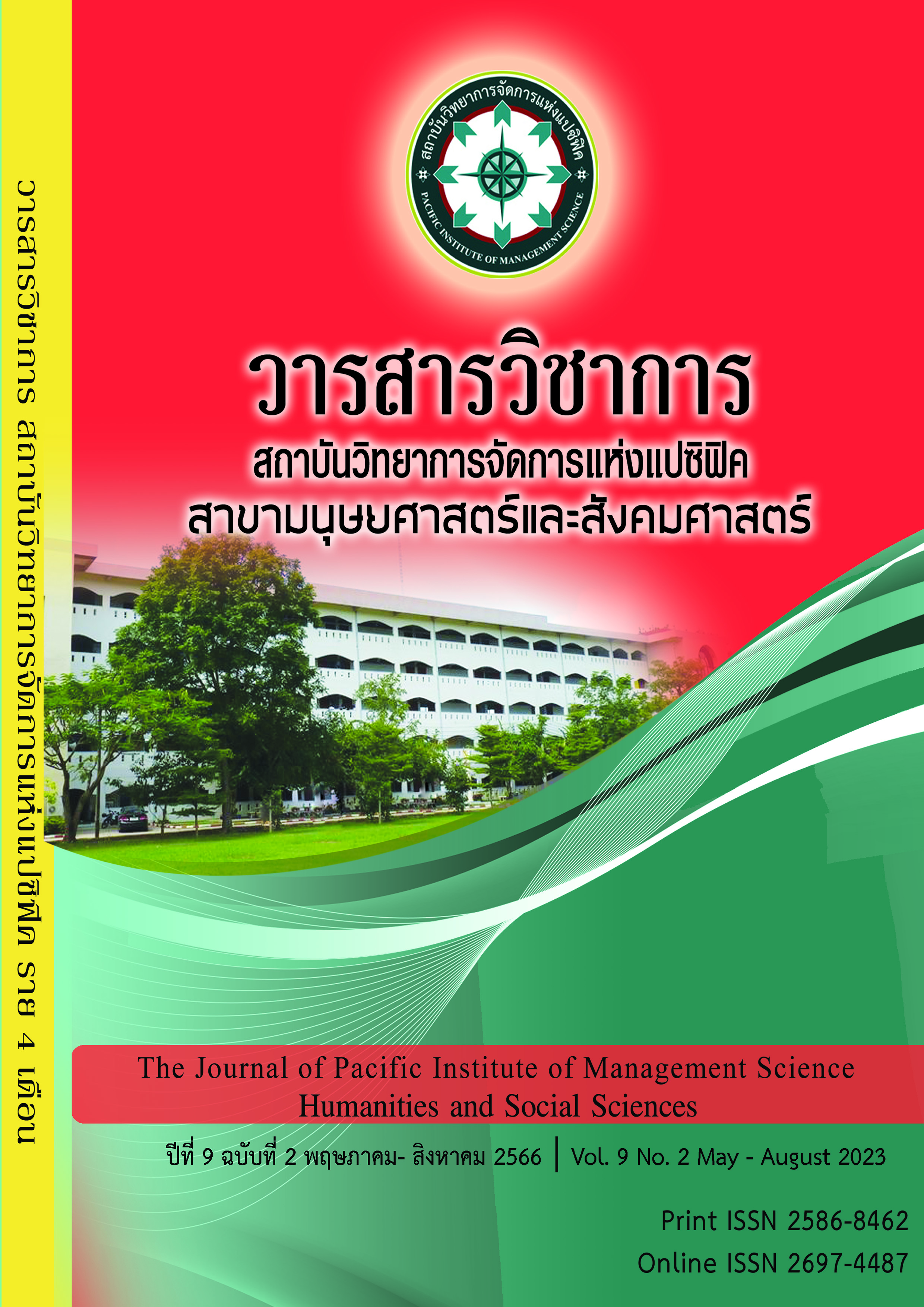Studying and developing prototypes of the plan management system and treasury
Keywords:
prototype, User, ProceduresAbstract
The research on the study and development of the model of the treasury plan management system aims to study the current operational procedures in the field of budget management and finance. To analyze the current business process to improve the procedures to be more efficient. Then is the prototyping process of the system. It is used to model the plan management system and treasury for use in budgetary operations. Finance The system prototype was tested by 21 operators to study the problem. Obstacles and suggestions The solution to the problem in the implementation of the system is divided into 3 aspects: personnel, developed systems, and environment by conducting user interviews and analyzing inductive data that interprets conclusions and presents lectures. As a result of studying and developing prototypes of the treasury management system, the procedures were implemented in 6 systems, namely budget system, purchasing system (AP), sales/revenue system (Account receivable: AR), financial and accounting system, fixed assets (FA), cost accounting system, and the system was introduced for users to test and interview for use by problems and obstacles of using the system. Personnel is a lack of knowledge and understanding of the use of the system. Lack of expertise results in delayed operations and incomplete data importation. Developed systems It's complicated, causing delays. There are some functionalities that do not cover the operation of the environment, and the problem is that the operating manual in the system is not yet detailed, the equipment is not conducive to operation, the internet network is unstable. Access to the system is not enough for the user. As a result, operators are not yet able to test the entire system. For suggestions and solutions, personnel. Users have offered to provide training. Communication, meeting, understanding of the use, and developed systems should be adjusted to reduce the complexity of the system. It is convenient and easy to cover operations and environmental aspects, and to prepare a detailed system operating manual to provide equipment that facilitates the operation. Have a person who is responsible for overseeing both the network and the system used to advise, advise and solve problems from use, and increase access rights to the system.
References
กระทรวงการคลัง. GFMIS. Retrieved from www.gfmis.go.th.
เขมวันต์ ปิติวีรารัตน์, สินีรัชต์ พวังคะพินธุ์, อรพรรณ คงมาลัย. (2553, กรกฎาคม-กันยายน).ปัจจัยด้านกลยุทธ์ต่อความสำเร็จการประยุกต์ใช้ SAP กรณีศึกษา การประปานครหลวง. จุฬาลงกรณ์วารสาร 22(88), 31-38
จิรัสย์ สิรินิวัฒน์กุล. (2558). ปัจจัยที่มีอิทธิพลต่อการยอมรับการใช้งานระบบ SAP ของหน่วยงานรัฐวิสาหกิจ: กรณีศึกษา สถาบันวิจัยวิทยาศาสตร์และเทคโนโลยีแห่งประเทศไทย. (ค้นคว้าอิสระ ปริญญาบริหารธุรกิจมหาบัณฑิต,มหาวิทยาลัยเทคโนโลยีราชมงคลธัญบุรี
จันจิรา ดีเลิศ, สุวรรณา สิทธินาวิวัฒน์ (2564). ระบบบริหารทรัพยากรองค์กร: เครื่องมือสู่ความสำเร็จอุตสาหกรรมการผลิตในประเทศไทย. วารสารวิทยาการจัดการปริทัศน์, ฉบับที่ 2 (กรกฎาคม-ธันวาคม 2564), 247-256.
วิภาดา บุญประกอบ. (2563). แนวทางการพัฒนาระบบสารสนเทศทางการบัญชีเพื่อการวางแผนและพัฒนาองค์กร(ERP) งานเงินทดรองราชการ มหาวิทยาลัยเทคโนโลยีราชมงคลตะวันออก.(รายงานวิจัย กองคลัง มหาวิทยาลัยเทคโนโลยีราชมงคลธัญบุรี)
วัชรพงศ์ จับแก้ว. (2551). ศึกษาความเหมาะสมในการนำระบบ ERP เข้ามาใช้ในสถาบันการศึกษา กรณีศึกษา มหาวิทยาลัยหอการค้าไทย.(ค้นคว้าตนเอง ปริญญาวิทยา ศาสตรมหาบัณฑิต,มหาวิทยาลัยหอการค้าไทย)
ศีจุฑา ปอน้อย. (2555). ความรู้และทัศนคติต่อการใช้งานระบบการวางแผนทรัพยากรองค์การของมหาวิทยาลัยเทคโนโลยีราชมงคลธัญบุรี.(ค้นคว้าอิสระ ปริญญาบริหารธุรกิจมหาบัณฑิต,มหาวิทยาลัยเทคโนโลยีราชมงคลธัญบุรี)
สุชาดา กีระนันทน์ (2541). เทคโนโลยีสารสนเทศ: สถิติ ข้อมูลในระบบสารสนเทศ. กรุงเทพฯ: โรงพิมพ์จุฬาลงกรณ์มหาวิทยาลัย.
สำนักโลจิสติกส์ กรมอุตสาหกรรมพื้นฐานและการเหมืองแร่. (ตุลาคม 2559). Best Practices และ Lessons Learned การประยุกต์ใช้ระบบเทคโนโลยีสารสนเทศ ERP. (ชัชพล มงคลิก, มหาวิทยาลัยเทคโนโลยีพระจอมเกล้าพระนครเหนือ.) บริษัท โรงพิมพ์วัฒนาพานิช จำกัด.
อัญญารัตน์ ธนไพศาลกิจ . (2552). ปัจจัยที่นำไปสู่ความสำเร็จของโครงการติดตั้งระบบ SAP ในหน่วยงานภาครัฐ:มุมมองของฝ่ายลูกค้าและฝ่ายผู้ให้บริการติดตั้งระบบ. (การค้นคว้าอิสระปริญญามหาบัณฑิต วิทยาลัยนวัตกรรม). กรุงเทพฯ: มหาวิทยาลัยธรรมศาสตร์.
อุบลวรรณ ขุนทอง, ศ. ค. (2557). ปัจจัยความสำเร็จของการใช้ระบบการวางแผนทรัพยากรองค์กร ด้านการบัญชีและการเงินที่มีต่อการเปลี่ยนแปลงบทบาทของนักบัญชีและนักการเงินและส่งผลให้เกิดประสิทธิภาพการดำเนินงานในองค์กรธุรกิจไทย. สุทธิปริทัศน์, 296-321.
อุราเพ็ญ ยิ้มประเสริฐ และรพีพร ตันจ้อย. (2558). ระบบสารสนเทศเพื่อการจัดการ สำหรับการบริหารสถาบันอุดมศึกษาที่เป็นการศึกษาอิเล็กทรอนิกส์. วารสารปัญญาภิวัฒน์. เข้าถึงได้จาก https://so05.tci-thaijo.org/index.php/pimjournal/article/view/39191/32462
Ehie, I.C., & Madsen, M. (2005). Identifying critical issues in enterprise resource planning (ERP) implementation. Computers in Industry, 56, 545-557.
Kowalski, T. J. (2003). Contemporary School Administration. Boston: Pearson Education.
Lockard, J. & Abrams, P. D. (2004). Computers for Twenty-First Century Education. (6th ed.). Boston: Pearson Education.
Thierauf, R. J. (1991). Executive Information System: A Guide for Senior Management and MIS Professionals. Quorum Books.
Yang X. (2009). Applying SAP ERP system in Business Processes, Case City of Tampere. UNIVERSITY OF APPLIED SCIENCES.
Zhang, L., and Li, Y. (2005). Probe into the way to implement ERP system in terms of systems theory in China. (Working paper). Beijing: Beijing Jiao tong University.
Downloads
Published
Issue
Section
License
Copyright (c) 2023 Pacific Institute of Management Science

This work is licensed under a Creative Commons Attribution-NonCommercial-NoDerivatives 4.0 International License.
บทความที่ได้รับการตีพิมพ์เป็นลิขสิทธิ์ของ สถาบันวิทยาการจัดการแห่งแปซิฟิค
ข้อความที่ปรากฏในบทความแต่ละเรื่องในวารสารวิชาการเล่มนี้เป็นความคิดเห็นส่วนตัวของผู้เขียนแต่ละท่านไม่เกี่ยวข้องกับสถาบันวิทยาการจัดการแห่งแปซิฟิค และคณาจารย์ท่านอื่นๆในสถาบันฯ แต่อย่างใด ความรับผิดชอบองค์ประกอบทั้งหมดของบทความแต่ละเรื่องเป็นของผู้เขียนแต่ละท่าน หากมีความผิดพลาดใดๆ ผู้เขียนแต่ละท่านจะรับผิดชอบบทความของตนเองแต่ผู้เดียว







